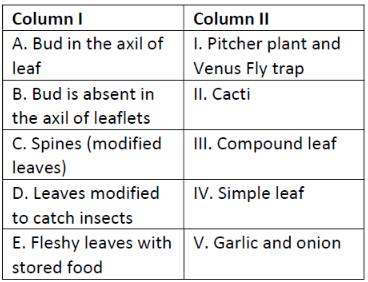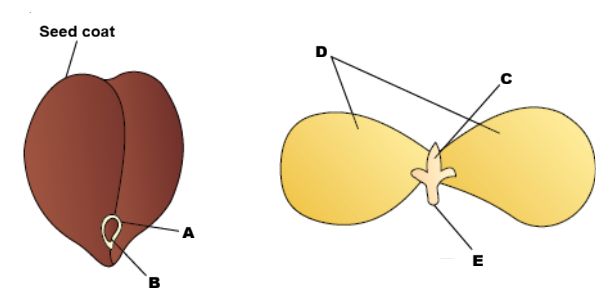Endosperm, a product of double fertilization in angiosperms is absent in the seeds of
1. Gram
2. Orchids
3. Maize
4. Castor
Which of the following plants is used to extract the blue dye?
1. Trifolium
2. Indigofera
3. Lupin
4. Cassia
What type of placentation is seen in sweet pea?
1. Axile
2. Free central
3. Marginal
4. Basal
In a cereal grain the single cotyledon of embryo is represented by
1. Scutellum
2. Prophyll
3. Coleoptile
4. Coleorhiza
An example of axile placentation is
1. Lemon
2. Marigold
3. Argemone
4. Dianthus
In unilocular ovary with a single ovule the placentation is:
1. Marginal
2. Basal
3. Free Central
4. Axile
The technical term used for the androecium in a flower of China rose (Hibiscus rosa sinensis)
1. Monadelphous
2. Diadelphous
3. Polyandrous
4. Polyadelphous
Consider the following four statements A, B, C and D and select the right options for two correct statements:
A. In vexillery aestivation, the large posterior petal is called - standard, two lateral ones are wings and two small anterior petals are termed keel.
B. The floral formula for Liliaceae is 
C. In pea flower, the stamens are monadelphous
D. The floral formula for Solanaceae is 
1. A and B
2. B and C
3. C and D
4. A and C
Which one of the following pairs is wrongly matched while the remaining three are correct?
1. Agave - Bulbils
2. Penicillium - Conidia
3. Water hyacinth - Runner
4. Bryophyllum - Leaf buds
Flowers are Zygomorphic in
1. Mustard
2. Gulmohur
3. Tomato
4. Datura
How many plants in the list given below have marginal placentation? Mustard, Gram, Tulip, Asparagus, Arhar, Sunhemp, Chilli, Colchicine, Onion, Moong, Pea, Tobacco, Lupin
1. Five
2. Six
3. Three
4. Four
Phyllode is present in
1. Australian Acacia
2. Opuntia
3. Asparagus
4. Euphorbia
Cymose inflorescence is present in
1. Trifolium
2. Brassica
3. Solanum
4. Sesbania
In China rose the flowers are
1. Actinomorphic, hypogynous with twisted aestivation
2. Actinomorphic, epigynous with valvate aestivation
3. Zygomorphic, hypogynous with imbricate aestivation
4. Zygomorphic, epigynous with twisted aestivation
Which one of the following statements is correct?
1. The seed in grasses is not endospermic
2. Mango is a parthenocarpic fruit
3. A proteinaceous aleuron layer is present in maize grain
4. A sterile pistil is called a staminode
Leaves become modified into spines in:
1. Pea
2. Onion
3. Silk Cotton
4. Opuntia
Flowers are unisexual in:
1. Onion
2. Pea
3. Cucumber
4. China rose
Root hairs develop from:
1. Region of maturation
2. Zone of elongation
3. Meristematic region
4. Region of mature cells
Stilt roots grow from -
1. Lower intemodes
2. Lower nodes
3. Upper nodes
4. Upper internodes
Prop or pillar roots in Banyan tree are
1. Fascicilated roots
2. Tap roots
3. Adventitious roots
4. Secondary roots
Stem tendrils (climbing in function) develop from the axillary bud. Stem tendrils are in all of the following except-
1. Cucumber
2. Citrus
3. Pumpkin
4. Watermelon and grapevines
Thorn develops from -
1. Root
2. Leaf
3. Axillary bud
4. Pedunce
In Banana, Pineapple and Chrysanthemum, the lateral branches originate from the basal and underground portion of main stem and then come obliquely upward giving rise to leafy shoots. These branches are called -
1. Runner
2. Sucker
3. Napiform
4. Phylloclade
In which of the following plants, underground stems spread to new niches and when older parts dies new plants are formed -
1. Pistia
2. Grasses and strawberry
3. Crocus
4. None of these
Leaf base is swollen to form pulvinus in -
1. Some leguminous plants
2. Some crucifers
3. Some monocots
4. Some cycads
Match Column I with Column II -
A B C D E
1. I II III IV V
2. V IV III II I
3. IV III II I V
4. IV II III I V
Palmate compound leaf is the one in which the leaflets develop from common point i.e. at the tip of -
1. Rachis
2. Branch of rachis
3. Petiole
4. Pedunce
Given below is the diagram of a typical leaf. In which of the following all the four parts labelled as A, B, C and D are correctly identified -
A B C D
1. Lamina Axillary bud Stipule Leaf base
2. Lamina Stipule Axillary bud Leaf base
3. Lamina Axillary bud Stipule Pedicel
4. Leaflet Axillary bud Stipule Leaf base
Which of the following is an incorrect match?
| 1. | Perigynous flower - Plum, rose and peach |
| 2. | Monadelphous - Pea |
| 3. | Epigynous flower - Guava, cucumber and ray florets of sunflower |
| 4. | Polyadelphous - Citrus |
Which of the following combinations is false?
1. Apocarpous - Carpels free - Lotus, Rose
2. Syncarpous - Carpels fused - Mustard, tomato
3. Placenta - arrangement of ovules within ovary
4. Arrangement of ovules within ovary - ovulation
Part of the fruit: Figure - I - Mango, Figure - U - Coconut are shown in the following diagram. A, B, C and D are respectively
1. Epicarp, Mesocarp, Seed, Endocarp
2. Epicarp, Mesocarp, Ovule, Endocarp
3. Epicarp, Mesocarp, Ovary, Endocarp
4. Epicarp, Mesocarp, Embryo, Endocarp
Given below is the diagram of a typical structure of dicotyledonous seeds. In which one of the options all the five parts A, B, C, D and E are correct?
1. A - Hilum, B - Micropyle, C - Radicle, D - Cotyledon, E - Plumule
2. A - Hilum, B - Micropyle, C - Plumule, D - Cotyledon, E - Radicle
3. A - Micropyle, B - Hilum, C - Plumule, D - Cotyledon, E - Radicle
4. A - Hilum, B - Micropyle, C - Plumule, D - Radicle, E - Cotyledon
Parthenocarpic fruit is a -
1. Seeded fruit
2. Seedless fruit
3. Single seeded fruit
4. Fruit of no use
One cotyledon is found in -
1. Wheat and maize
2. Gram and pea
3. Bean and gram
4. Ground nut and pea
Find out the false statement -
1. In dicotyledonous seeds, cotyledons are often fleshy and full of reserve food
2. Generally, mocotyledonous seeds are endospermic
3. Generally, dicotyledonous seeds are non-ednospermic
4. Most of the monocotyledonous seeds have fleshy cotyledons
Match the Column I and choose the correct answer
Column I Column II
A. Coleorrhiza i. Grapes
B. Food storing tissue ii. Mango
C. Parthenocarpic fruit iii. Maize
D. Single seeded fruit developing from monocarpellary superior ovary iv. Radicle
E. Membranous seed coat v. Endosperm
1. A-iii, B-i, C-iv, D-ii, E-v
2. A-iv, B-ii, C-v, D-i, E-iii
3. A-v, B-i, C-iii, D-iv, E-ii
4. A-iv, B-v, C-i, D-ii, E-iii
Which of the following is characteristic feature of Fabaceae?
1. Descending imbricate, ten stamens, diadelphous, ovary inferior
2. Sepals five, gamosepalous, imbricate aestivation, axile placentation
3. Monocarpellary, ovary inferior, style long, slightly bent at the apex
4. Zygomorphic flowes, vexillary aestivation in corolla, monocarpellary, ovary superior, diadelphous, ten stamens, many ovules, placentation marginal
Belladona is the drug alkaloid extracted from the leaves of -
1. Datum stramonium
2. Solanum teberosum
3. Atropa belladona, Solanaceae
4. Rauwolfia serpentina
Colchine is obtained from a member of-
1. Solanaceae
2. Liliaceae
3. Fabaceae
4. Brassicaceae
G and indicate -
1. Epigymous and hypogynous flowers
2. Superior ovary and inferior ovary
3. Presence and absence of gynoecium
4. Fused and free gynoecium
Whorled, simple leaves with reticulate venation are present in:
1. Calotropis
2. Neem
3. China Rose
4. Alstonia
Sweet potato is homologous to:
1. Potato
2. Colocasia
3. Ginger
4. Turnip
Seed coat is not thin, membranous in:
1. Maize
2. Coconut
3. Groundnut
4. Gram
The common characteristics between tomato and potato will be maximum at the level of their
1. Genus
2. Family
3. Order
4. Division
Among flowers of Calotropis, tulip, Sesbania, Asparagus, Colchicine, Sweet pea, Petunia, Indigofera, Mustard, Soy-bean, Tobacco and groundnut how many plants have corolla with valvate aestivation?
1. Five
2. Six
3. Seven
4. Eight
How many plants among China rose, Ocimum, sunflower, mustard, Alstonia, guava, Calotropis and Nerium (Oleander) have opposite phyllotaxy?
1. Two
2. Three
3. Four
4. Five
Inflorescence is racemose in
1. Sovabean
2. Brinjal
3. Tulip
4. Aloe
Which among the following are wrong statements?
| I. | In cymose inflorescence flowers are borne in a basipetal manner. |
| II. | In rose, flowers are epigynous. |
| III. | In Alstonia, the phyllotaxy is whorled. |
| IV. | Potato is an underground root of food storage. |
1. I and II
2. II and III
3. II and IV
4. I and IV
Consider the following statements.
A. In leguminous plants, leaf base becomes swollen, called pulvinus.
B. The fleshy leaves of onion and garlic store food.
C. The buds in Australian Acacia tree become green and synthesise food.
D. In Alstonia, leaves show alternate phyllotaxt.
Of the above statement
1. B and D are correct
2. A and C are correct
3. A and B are correct
4. A and D are correct